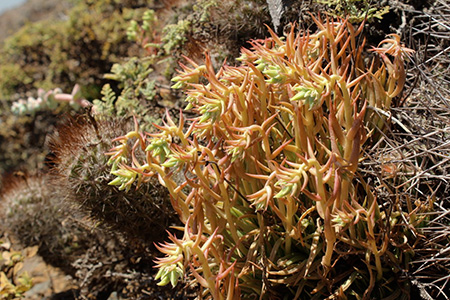Campus News
Two new species of rare succulents found in Mexico named by UCSC botanist
A retired staff botanist at the UCSC Arboretum & Botanic Garden studied the rare plants found on an island off the coast of Baja California and identified two new species of dudleya.


Stephen McCabe, emeritus director of research at the UCSC Arboretum & Botanic Garden, has described two new species of rare succulents in the genus Dudleya. McCabe identified the new species after studying small populations of the rare plants found on Isla Cedros, an island off the west coast of Baja California, Mexico.
There are about 48 species of dudleyas (also known as “liveforevers”), more than half of which are native to California, growing on cliffs and rocky habitats along the coast. Many dudleya species are rare, including 10 native to California that are classified as threatened or endangered. Unfortunately, as dudleyas have become popular with collectors, especially in Asia, they have been targeted by poachers who collect them from the wild.
McCabe said he had conflicted feelings about naming the new species. “If a species has not been named, it is unlikely to get any formal protection,” he said, “but if it is named, it might become attractive to poachers.”
So far, he said, the two new species don’t seem to have the characteristics of other species of Dudleya that have been the target of poachers. Their small populations, however, make them vulnerable to even minor amounts of poaching and to other threats such as climate change. McCabe described the new species in a paper published in January in Madroño, the journal of the California Botanical Society.
Dudleya delgadilloi is named in honor of a prominent Mexican botanist, José Delgadillo Hernandéz, professor and director of the herbarium at the Universidad Autónoma Baja California en Ensenada. The plants grow on a remote ridge on Isla Cedros, scattered across an area of about 2 acres. Another species found in the same area, Dudleya pachyphytum, has been targeted by poachers, who hired a helicopter to access the ridge, McCabe said.
The other new species, Dudleya cochimiana, is named after the local indigenous Cochimí people and their language. Although it occurs in several places on the island, Dudleya cochimiana is not abundant. José Sanchez, who lives on the island and is a founder of the conservation group Conservation de las Islas, helped transport McCabe and colleagues to some of the obscure locations and to starting points for hikes to the plant habitats.
The paper provides not only detailed descriptions of both species, but also discussions of their relationships to other species, their distributions and habitats, and threats to their populations.
“Naming a new species is a big deal,” said Brett Hall, director of the Arboretum’s California Native Plant Program. “It’s a lot of work to present the scientific evidence and go through all the vetting and peer review, but Steve is a recognized authority on this genus.”
Although he retired several years ago, McCabe still contributes to the Arboretum’s plant conservation efforts and continues his decades-long work on the genus Dudleya. Thanks to his expertise, the UCSC Arboretum is a designated rescue center for plants that authorities have seized from poachers, helping with efforts to replant them in the wild when possible. The Arboretum has a large dudleya collection and uses responsible propagation to make the plants available to other botanic gardens and to the public.
“They’re beautiful plants, and horticulturally they are very sought after, which is why poaching became such an issue,” Hall said. “Responsible propagation can help to discourage people from collecting plants from the wild, which is now illegal in California for the whole Dudleya genus.”
Maintaining collections in botanic gardens is also important in case wild populations are decimated by poaching, wildfire, or other events. The Arboretum will propagate some of the D. delgadilloi specimens, making them available first to other botanic gardens and later to the public. Seeds of both new species will also be maintained in the Arboretum’s seed bank and shared with other conservation seed banks through the Center for Plant Conservation.
“Conservation of rare and endangered species, especially of California natives, is an important aspect of the Arboretum’s work,” said Arboretum Director Martin Quigley. “Much of that work is not really visible to the public, so it’s great when new species are identified and targeted for preservation through breeding and eventual redistribution.”